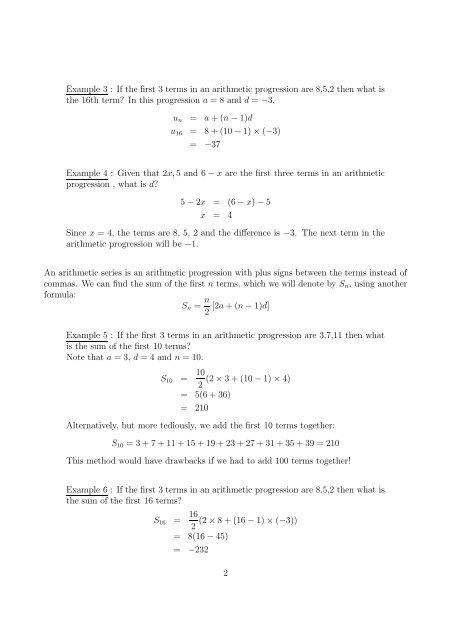Worksheet 3.6 Arithmetic and Geometric Progressions
Worksheet 3.6 Arithmetic and Geometric Progressions
Worksheet 3.6 Arithmetic and Geometric Progressions
You also want an ePaper? Increase the reach of your titles
YUMPU automatically turns print PDFs into web optimized ePapers that Google loves.
Example 3 : If the first 3 terms in an arithmetic progression are 8,5,2 then what is<br />
the 16th term? In this progression a = 8 <strong>and</strong> d = −3.<br />
un = a + (n − 1)d<br />
u16 = 8 + (10 − 1) × (−3)<br />
= −37<br />
Example 4 : Given that 2x, 5 <strong>and</strong> 6 − x are the first three terms in an arithmetic<br />
progression , what is d?<br />
5 − 2x = (6 − x) − 5<br />
x = 4<br />
Since x = 4, the terms are 8, 5, 2 <strong>and</strong> the difference is −3. The next term in the<br />
arithmetic progression will be −1.<br />
An arithmetic series is an arithmetic progression with plus signs between the terms instead of<br />
commas. We can find the sum of the first n terms, which we will denote by Sn, using another<br />
formula:<br />
Sn = n<br />
[2a + (n − 1)d]<br />
2<br />
Example 5 : If the first 3 terms in an arithmetic progression are 3,7,11 then what<br />
is the sum of the first 10 terms?<br />
Note that a = 3, d = 4 <strong>and</strong> n = 10.<br />
S10 = 10<br />
(2 × 3 + (10 − 1) × 4)<br />
2<br />
= 5(6 + 36)<br />
= 210<br />
Alternatively, but more tediously, we add the first 10 terms together:<br />
S10 = 3 + 7 + 11 + 15 + 19 + 23 + 27 + 31 + 35 + 39 = 210<br />
This method would have drawbacks if we had to add 100 terms together!<br />
Example 6 : If the first 3 terms in an arithmetic progression are 8,5,2 then what is<br />
the sum of the first 16 terms?<br />
S16 = 16<br />
(2 × 8 + (16 − 1) × (−3))<br />
2<br />
= 8(16 − 45)<br />
= −232<br />
2
















